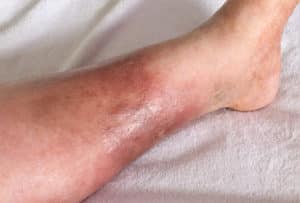
What is Chronic Venous Insufficiency?
We hear about spider veins and varicose veins, but we rarely hear the medical terminology associated with them. These vein conditions are characteristic of chronic venous insufficiency, a problem with one or more valves in a vein. The veins return deoxygenated blood to the heart for oxygenation before it circulates back out into the body. The leg veins are working against the force of gravity. Circulation is assisted by the contraction of calf muscles (which is why it is important to stand up and move around frequently throughout the day) and also by valves along the veins. One-way valves open for blood to move up the leg, and close to prevent pooling. Damage to the vein can alter the way the valves close, allowing blood to stagnate just before the valve. In a superficial vein, this causes the swelling we know as a varicose vein. In a deep vein, the blood forms the clot we know as deep vein thrombosis.
Deep vein thrombosis may result from narrowing in a deep vein or from a lack of physical activity. This is one of the reasons doctors advise patients to walk as soon as they can after having surgery. Leading a sedentary lifestyle can also impair the functionality of superficial and deep veins, increasing the risk of chronic venous insufficiency and deep vein thrombosis. The concern regarding DVT, as opposed to varicose veins, is that, when a blood clot forms in a deep vein, it can at some point dislodge and travel through the vein to the lungs. The veins in the lungs decrease in size, so the clot eventually gets caught. The blockage can cause severe, life-threatening breathing difficulty.
Signs of DVT
People with varicose veins should not wait to notice signs of deep vein thrombosis to consult with a vein and vascular specialist. There is immense value in working with a doctor to better understand and manage chronic venous insufficiency in its early stages, as well as to know the signs of deep vein thrombosis. These include:
- Skin discoloration (red or blue) over the site of the DVT
- Swelling in a foot, ankle, or leg
- Severe cramping of the calf muscle
At Minimally Invasive Vascular Center, patients receive care from a triple-board certified vascular specialist. For more information or to schedule a consultation, contact our Laurel, MD facility at (855) 803-MIVC (6482).


Monday – Thursday: 9am – 5pm
Friday: 9am – 1pm
Saturday – Sunday: Closed